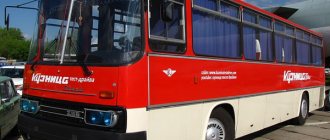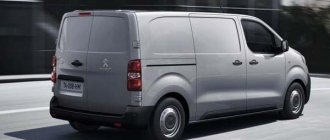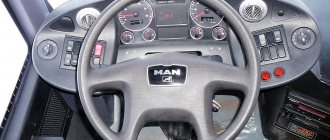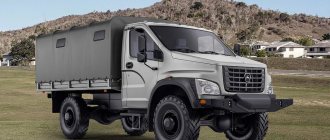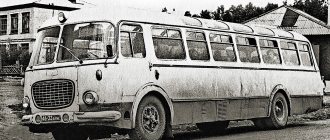PAZ-32053
PAZ is a real long-liver of the domestic automobile industry. The first bus in Pavlov-on-Oka was assembled in the Soviet Union, and production continues to this day. During this time, the bus (naturally) went through a number of modernizations, and the currently produced model 3205 is the fourth in a row.
A kind of business card of the enterprise is the PAZ-32053 bus, as a continuation of the 05 model. Since the release of the first 32053, the bus has undergone significant changes, and to date more than 30 modifications have been produced. Not to mention the fact that, unlike all other buses, this one is truly “Russian”.
Since the first bus came off the assembly line, the model has changed and expanded, but its main quality has remained unchanged - it is a compact vehicle, not designed to transport a large number of people. Due to its versatility, the bus has found its place where it is not always profitable to run vehicles with a larger capacity.
PAZ-32053 successfully operates both on rural and suburban routes, and in the city - in minibus mode. It is worth noting the reliable suspension, which is a very noticeable plus on today's roads. The suspension holds the cabin quite high, which is especially valuable in suburban conditions. And the fact that the bus is manufactured in Russia plays an important role in the availability of spare parts.
PAZ-4230 "Aurora"
Is it really so bad that Aurora was created on familiar, operationally proven components?
87931[/snapback]
In general, yes, it’s bad, if only these units were of high quality, otherwise... The clutch is well described in the Auto Review. Or could they install an automatic transmission?
87971[/snapback]
True, Autoreview describes how the Aurora is operated on an urban-suburban semi-express route in a metropolis, and in bobby mode. And 4230 and its extended version are a bus for local transport, or for urban transport in small towns, which I was lucky enough to observe this summer, as well as for official transport and using it otherwise is at least strange...
But I don’t understand why a bus that is not intended for urban transportation needs an automatic machine.
Disgusting, creepy and terrible. The whole problem is that these proven units were developed for completely different machines, and if you put a bridge from a PAZik on a long Aurora, then the difference in weight will make itself felt by increased wear of the rare earth parts, and the MMD engine was made for a small tractor not weighing under 8 tons with a full load and this engine will tell you “bye” and its repair will increase the cost of maintaining the fleet, increase ticket prices, reduce the activity of the population, and create demand for foreign ones. HARMONIOUSLY designed technology. In short, the lack of management of the entire chain of “designing units for a specific class of vehicles - designing a specific class of vehicles - production - operation” leads to the fact that the manufacturers themselves ruin the carrier by pushing him under any pretext (censored) and ruin their own potential demand, because the market is not rubber, simply increased funds (and maybe part of the depreciation) for repairs will not allow us to update the car faster, or even use it more intensively.
If PAZ were selling cars with the slogan “Readiness rate - 95% over a period of 7 years - guaranteed” - it would be selling a product called “Fixed assets for the transportation business”, but now they are selling crookedly made collectible cars not for business, but for politics, PR and other crap so far from our frosty reality, and the path they follow does not inspire confidence and does not form clear prospects for the future. In short, they are pests of the domestic mechanical engineering industry.
88029[/snapback]
It seems to me that you got a little excited. I agree that installing an engine of insufficient power and chassis components not designed for the weight of the vehicle on a longer bus. Moreover, in his first message in this topic he just said that large gaps between gear ratios in the Aurora gearbox are a clear drawback of the bus, i.e. lack of thought for using it for its intended purpose, i.e. for local transport.
In general, the tractor diesel on the short version of the Aurora copes with its task quite well. The long version is another matter. About two years ago I talked with representatives of PAZ and asked a question about the engine, because a tractor engine is not a bus engine. The answer was this: We generally want to install a Yaroslavl four-cylinder diesel engine, but it doesn’t exist yet, and the larger one doesn’t fit into the Aurora’s engine compartment.
Today YaMZ announces its readiness to produce in-line diesel engines of the 500th family. Maybe they will appear on Aurora. Unless interdepartmental, I beg your pardon, inter-holding confusion gets in the way. For a long time I couldn’t understand why Russian buses don’t like Yaroslavl engines so much, but now it dawned on me: the owners of LiAZ, PAZ, KAVZ, GOLAZ and YaMZ are different.
Moreover, how suitable the CAMINS will be for a long groove is a big question. At least the engines that are on low-floor grooves (if I’m not mistaken by DEITZ) are clearly not good for the money - they are very tense on the body...
As for the reliability of the units, everything is decided very simply: there is such a price-quality ratio and, as far as I know, Russian buses monitor this very carefully.
Unfortunately, today most of our carriers are not ready to pay more for cars than they pay.
Interesting Facts
Interestingly, this version of the bus is not the first in its line, but nevertheless has one automatic door. The second, located in the rear of the passenger cabin, is a regular car one. In some manuals it is called emergency. Two automatic doors on the high-floor bus appeared only in the next modification - 32054.
The first bus of this class rolled off the assembly line in 1989. It’s interesting that a seemingly small bus takes about 2 months to assemble.
Modern comfortable bus
The PAZ 3204 bus rolled off the plant’s assembly line in 2007. It is actively used in commercial passenger transportation on urban and suburban routes, has good maneuverability in dense traffic, and has a turning radius of 8.1 meters.
The body of the new PAZ 3204 wagon layout is installed on a base 3800 mm long with a 4x2 wheel arrangement. Bus height 2880 mm, bus length 7600 mm, width 2410 mm. The interior has a standard ceiling height like all PAZ models – 1985 mm. It is ventilated using vents in the side windows and hatches with rubber seals in the cabin roof.
Buses of various modifications of this model are designed to transport up to 52 people. Depending on the configuration, the cabin has 18 or 19 seats for passengers. The seats are in-line, the installation of additional ones does not interfere with the comfort and ability of passengers to move around the cabin.
When producing the first buses of this modification, the designers installed an air suspension on the vehicle. It caused constant negative feedback from PAZ 3204 consumers, so it was replaced with a dependent spring one. Both the front and rear suspensions are equipped with telescopic shock absorbers, while the rear suspension also has corrective springs. The bus is designed for operation in various road conditions. Since 2009, the new Paz 3204 has been available with spring suspension.
The steering mechanism is equipped with a hydraulic booster, and comfortable working conditions have been created for the driver. In addition to replacing the suspension, the designers have modernized the interior of the car: the Paz 3204 floor has become single-level, and thanks to the installation of 245/70 R19.5 tires, the level of the platform has been lowered, which has brought additional convenience to passengers when boarding the bus.
The autonomous pre-heater and interior heaters are powered by the engine cooling system. The interior of the PAZ 3204 is heated by 4 heaters; a separate one is provided for the driver’s workplace.
Prices,
Carriers also appreciate the high maintainability and affordable price for everyone, even small enterprises.
A new bus can be purchased from several suppliers, in addition to the manufacturer. several more companies keep factory prices for PAZ-32053. The price of a new bus, for example in Nizhny Novgorod, starts from 1-1.3 million rubles. As always, prices in Moscow will be slightly higher. Thanks to the large number of modifications available, from regular commuter models to urban options, you can choose the version you need. Among the modifications, a special place was occupied by the version of the bus for transporting children, the so-called
School bus
Despite the large number of modifications, the PAZ-32053 remains almost unchanged in appearance. There are minor changes for better use, with the exception of one modification - 70. The PAZ-32053-70 bus was initially developed as an option with a diesel engine, but then received an official name - a school bus.
Due to the new name and application, the bus body has undergone some changes. Unlike the basic one, it has 4 steps in front of the front door (the lowest of which is retractable), standard yellow paint, a megaphone on the roof and a reflective strip along the body.
Some export versions are also equipped with a yellow flashing light. The interior of the cabin has undergone some changes. The school PAZ-32053 has seats with a high semi-soft back, seat belts on each seat, each of which has a driver signal button. There is also a special shelf for school bags in the cabin.
Now, having an idea of the modifications and prices, it’s time to look at the technical characteristics of the Russian bus. Detailed technical characteristics of PAZ-32053 are given below in the summary table. Model 32053-07, a “city” bus, is described.
Almost every modification received its own version of the engine. Thus, a commuter bus is usually equipped with a ZMZ-5234.10 engine with 8 cylinders and a power of 140 hp. Cargo-passenger and specialized versions have less powerful engines, up to 130 hp. Options with a diesel engine stand out, which are mostly equipped with imported engines.
Fuel
And of course, as when describing any vehicle, we can mention the fuel consumption of the PAZ-32053. It should be noted that over its long history, the bus was produced with engines of different generations. Therefore, the final owner of the bus needs to very carefully check the fuel characteristics in the “Octane Number” section. There are still buses that run on 76 gasoline. But for relatively new buses, 92 gasoline is generally prescribed. Per 100 km, the usual figures will be 18 liters on the highway, or 20-21 in urban use. For comparison, we point out that the Chevrolet Niva in the city can use up to 14 liters.
Bus technical characteristics
The car is available with three engine models. Either a YaMZ-534 engine with a 150 l/s, four-row diesel engine, or more powerful (168 and 183 horsepower) German Cummins with a displacement of 4.5 liters is installed. Engine models meet Euro-3 and Euro-4 environmental standards.
When fully loaded, a car can travel at a speed of 90 km/h, consuming 20 liters of fuel per 100 km. All models are equipped with a 105 liter fuel tank. Some bus modifications are equipped with an automatic transmission, but more often a five-speed manual transmission with remote drive is installed.
Based on the PAZ 3204, the PAZ 320402-05 bus was created with a modified appearance. The designers replaced the headlights and interior trim. Compared to earlier models, this car is designed for eight years of operation (versus a 6-year warranty for previous versions). The bus body is galvanized, with special anti-corrosion treatment. For emergencies, the bus is equipped with hammers for breaking windows installed in rubber seals.
PAZ 320402-05 is used not only on city passenger routes, but is also used to transport students as a school bus with appropriate equipment for their safety (seat belts, separate places for transporting school bags and briefcases), the presence of emergency stop buttons, the possibility of emergency door opening .
The difference between this modification and the basic one is also the increase in seats for passengers (up to 25 when using the bus on intercity flights), and the presence of a forced interior ventilation system.
The driver's seat in PAZ 320402-05 is separated from the passenger compartment by a partition with a sun curtain; a handrail for passengers is installed on the partition. The driver's seat provides storage space for personal belongings.
The technical characteristics of the PAZ 320402-05 wheelbase have not changed. Inside the bus, the front door (both pneumatically operated doors are 650 mm wide) has been moved closer to the front axle. The bus is equipped with German diesel engines with turbocharging and intercooling of charge air, environmental safety class Euro-3, Euro-4.
Fuel consumption of PAZ 320402-05 is at least 20 liters per 100 km. The load on the front axle of the bus is 3090 kg, on the rear axle – 6690 kg. The total weight of the vehicle is 9780 kg. Due to the increase in the rear overhang, the turning radius of the PAZ 320402-05 bus increased to 9.1 meters.
The PAZ 3204 brake system meets modern safety requirements for passenger transportation in terms of technical characteristics. PAZ 320402 (another bus modification) was recognized as the best in its class at several passenger transport exhibitions, since it was one of the first models equipped with a motor brake as standard.
The brake operating system is divided along the axes, dual-circuit with pneumatic drive. The parking brake of the PAZ 3204, as well as all modifications (PAZ 320402, PAZ 320402-05, PAZ 320402-03), also with a pneumatic drive, acts on the rear wheels. Either of the two circuits of the service brake system can serve as a spare brake circuit. All bus models are equipped with an anti-lock braking system.
All PAZ 3204 buses are practical to use due to the availability of spare parts, thanks to a well-developed dealer network. If we consider the technical characteristics of all modifications, they differ only in the details of the interior layout in terms of the number of seats, engine modifications, gearboxes and axles. The price of new buses of the PAZ 3204 model ranges from 1,900 thousand rubles to 2,400 thousand.

